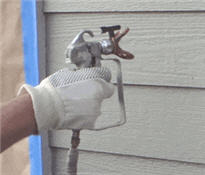
Painting Your House and Painters
Unsure of your next painting project and which painter to go with? Cost
is only one factor and there are different ways to complete
a project. Here are some commonly overlooked items among many:
First, application. Are the painters using spray/brush or roll. Know if they are
going to spray. For the interior this can achieve a glassier surface and will require
masking unprotected areas.
On rougher exterior surfaces, like rough sawn siding, usually only if necessary
will contactors “back brush” or "back roll" to actually
work the material into below the surface for a more complete seal. Actually
a great number of new homes receive spray coats, that could of lasted longer
had they been back brushed, but keep in mind that this is simply not the norm
and requires much more on the labor side of things.
A note on exterior surface preparation:
Address the areas that need to be scraped and primed (as well as for worn
or exposed areas). Contrary to opinion, primer is not just "watered
down" paint as seen by some and primer does have the design
of giving some degree of sealing properties and adhesion on to the finish coat.
The right primer can mean added years of useful service to your project.
A note on interior surface preparation:
Priming interior trim and wood finish areas can result in greater coverage and smoother
end-result when the primer is properly sanded before the application of the finish coat.
Patching of the walls is crucial to achieve a smooth finish. There are a variety
of
drywall
patching techniques to suit the particular application and a list of
drywall repair tips for preparing the walls and
ceiling repair for up above.
Not to be overlooked. However these patches and repairs
need not always be done by the painting professional.
If you must paint an area that is subject to damage, spots should be
addressed for the
patching a large hole
or if there is more severe damage, the
patch
of many holes is an absolute must, planning for the fact that dry
times will be needed prior to application of primers and finish coats. Again,
not always performed by the house painter.
Caulking is another important item. Unless your dealing with commercial caulking contractors, or
adventuresome carpenters, this usually falls under the auspice of “Painting.”
Look for siliconized caulk to be used, and not 100% silicone for paintable
surfaces since paint will bead off pure silicone. For exteriors, caulking helps keep weather and
moisture out and from penetrating where it shouldn't.
Depending on local climate, get a recommendation on the sheen. Higher glosses
can extend the life of finish while preserving the surface. Though keep in
mind too that the higher sheens generally don't cover as well and can mean
that an extra coat be applied by the contractor.

